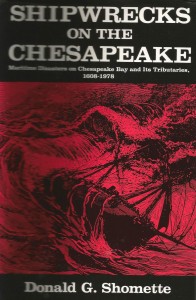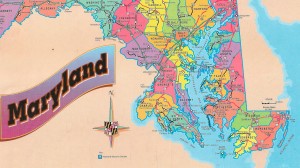Shipwrecks of the Chesapeake

John Kellett & Jesse Levovics of Bladensburg, MD position the bow cannon of a replica of one of Barney’s Barges. Barney sank his flotilla to avoid its capture.
An estimated 1,800 wrecked or abandoned ships, sailing during Colonial times to modern days, lie on the bottom of the Chesapeake Bay and its tributaries. From the Susquehanna River to Cape Charles, they foundered in storms, ran aground, blew up, were rammed, ice-crushed or scuttled. Schooners, sloops, steamers, ferries, frigates, freighters, barks, bugeyes and barges met their fates in murky waters that claimed passengers, crews and cargoes.
The Mallows Bay Ghost Fleet comprises one of the largest maritime graveyards in North America. Hardly a bay, it’s just a narrow gouge in the shore along the Potomac River, Charles County, Maryland, but shelters nearly 100 shipwrecks in its shallow, dark waters. Nicknamed the “Ghost Fleet,” this depository of wooden steamships was hastily built during World War I when President Woodrow Wilson ordered them to be constructed in a hurry to thwart marauding German submarines. Ninety were christened in one day in 1917, but ran into trouble when their coal-burning engines were rendered obsolete by diesel power. By the time the war ended in 1918, no one wanted the vessels which were salvaged for parts and then scuttled. Throughout the years they became shallow water derelicts with trees and bushes replacing rotted wooden decks. But recently, they acquired a new life. The Federal Government, recognizing the area’s historical and ecological significance, declared the area a National Marine Sanctuary. Now, visitors can explore the 14-square-miles of land and water, some of them opting to kayak or canoe past these hulks of another heyday.

Shipwrecks of the Chesapeake
History lives in the Chesapeake where the War of 1812 played a major role. Native Marylander Joshua Barney, a hero in the Revolutionary War, was a staunch defender of the Bay when the British were attacking it in the summer of 1814. Barney, with approval from the Secretary of the Navy, constructed and restored 18 vessels called the Chesapeake Flotilla to battle the British when they came up the Patuxent River. Many of the vessels looked liked enlarged rowboats propelled by men rowing two abreast with 16-foot oars. Others manned the cannons at the bow and stern.
When British General Robert Ross sailed up the river with his ships and thousands of soldiers, Barney and his men fought valiantly, but had to scuttle the fleet to prevent its capture. The flotilla, called “Barney’s Barges,” rests on the bottom of the Patuxent, a reminder of heroic efforts to defend our land and waters.
Not to be forgotten, Barney’s legend has been resurrected by local shipwrights John Kellett and Jess Lebovics who built a replica of one of the barges as part of the 300th birthday celebration of Prince George’s County. Docked at the Bladensburg waterfront, the boat remains a tourist attraction as well as a teaching vessel for Baltimore’s Living Class Foundation.

Maryland Map
The historic Mallows site and Barney’s Flotilla are protected by state and federal laws, but sport divers retrieve artifacts from later wrecks such as the steamship New Jersey. The Old Bay Line’s vessel caught fire while on a general freight run from Baltimore to Norfolk, Virginia, sinking in 80 feet of water eight miles from the western shoreline of the upper Bay. Divers brave the nearly zero visibility waters to salvage the milk-glass molasses and hobnail syrup pitchers still in the hold. They named it the “Pitcher Wreck” after its discovery in 1975.
The three-masted schooner Levin J. Marvel, converted from a cargo carrier to a passenger ship with 17 staterooms, sank in August, 1955, a victim of Hurricane Connie. Winds and waves rolled it over in the shallow waters of Holland Bay, Calvert County, Maryland. Fourteen of the 27 passengers perished. Six of the survivors sought refuge in a duck blind that was washed away right after they were rescued.
The Herbert D. Maxwell, a handsome four-masted schooner, was rammed by the steamer SS Gloucester during a storm in 1812. It sank in 70 feet of water off Kent Island, near what is now the Chesapeake Bay Bridge.
The list continues: hundreds of ships lost over hundreds of years. Much of it is chronicled in an outstanding book: Shipwrecks on the Chesapeake by Donald G. Shomette. The author has visited many of the Chesapeake’s wrecks and uses his first hand knowledge and extensive research to capture these epochs of bygone days.
9 Comments
Submit a Comment
All Rights Reserved © | National Underwater and Marine Agency
All Rights Reserved © | National Underwater and Marine Agency
Web Design by Floyd Dog Design
Web Design by Floyd Dog Design

Hello,
What is NUMA’s opinion of Capt. David Williams deafwhale.com site and his “solutions” to the USS Scorpion’s sinking, the Mary Celeste mystery and the stranding of whales?
Thank you
Why did the men go out on the ships if it was bad weather?? Greed? or stupid?
The reason Why I am asking is I do not go out driving when it is bad weather. I like your book that you write about Dirk . I know it is only fairytale, but it is nice.
I had a relative who drowned in the Chesapeake Bay in 1817 – Charles Collins. We believe the ship he was on as a sailor sunk. I am trying to locate ship wrecks in that year. Any suggestions on how I might do that?
You might be interested in obtaining a copy of Shipwrecks on the Chesapeake by Donald G. Shomette, (Ebay and/or Amazon). It is excellent. He lists many wrecks of the Chesapeake. Only one is listed for your time table of 1817. It is the HANNAH, a brig wrecked at the mouth of the Potomac River, Maryland. There are no details given, but this does give you a starting point. I haven’t been in touch with Mr. Shomette for some years, but you might try to locate him on the internet. He is from Dunkirk, MD 20754. I’m sure he can give you more to go on.
Back in the 70s my friends tried to steal the bell from Ft Carroll in a 19′ roundabout. They lost control of the bell and it fell striking the rocks before sinking into the water just missing their boat. I bet its still in the water below the old tower
I suggest you write an anonymous letter to Mr. Mark Letzer, President & CEO of the Maryland Historical Society, 201 W. Monument St., Baltimore, MD 21201. He might be interested in following up on this.
You might send an anonymous letter to Mr. Mark Letzer, President & CEO, Maryland Historical Society, 201 w. Monument St., Baltimore, MD 21201. He might be interested in this.
I suggest you send an anonymous letter to Mr. Mark Letzer, President & CEO, Maryland Historical Society, 201 W. Monument St., Baltimore, MD 21201. He might be interested in this.
In late 1864 or in 1865 Union Troops were crossing the Chesapeake so the troops could go home. Some had been POW’s in Andersonville Prison that were exchanged. One of the ships was “Govenor ?. The three ships (I think) were caught in a storm while crossing and sank. Is there a list of the soldiers who lost there lives published somewhere?